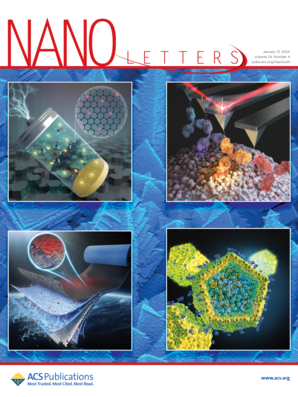封装WSe2单层中Rydberg激子及其光诱导带电配合物的超快动力学
IF 9.6
1区 材料科学
Q1 CHEMISTRY, MULTIDISCIPLINARY
引用次数: 0
摘要
量子约束和减少介电屏蔽导致了原子薄过渡金属二硫族化合物(TMDs)中的强激子效应。在六方氮化硼(hBN)中封装TMD单层揭示了自由粒子带隙以下的激子Rydberg系列。这些高阶激子态及其多粒子复合物的非平衡响应和动力学几乎尚未被探索。在这里,我们使用超快泵浦探针光学显微镜测量了hbn封装单层WSe2中激发态(2s)激子的动力学。2s激子是通过超快弛豫过程从高能态形成的,由于其更高的空间扩展,表现出比基态激子更长的衰减动力学。由于激子内俄歇效应导致了额外的衰变通道,我们探测到光诱导形成的2s三角子具有显著的振子强度和比2s激子更快的衰变动力学。我们的结果揭示了tmd中激发态激子的动力学及其与自由载流子的相互作用。本文章由计算机程序翻译,如有差异,请以英文原文为准。

Ultrafast Dynamics of Rydberg Excitons and Their Optically Induced Charged Complexes in Encapsulated WSe2 Monolayers
Quantum confinement and reduced dielectric screening lead to strong excitonic effects in atomically thin transition metal dichalcogenides (TMDs). Encapsulation of TMD monolayers in hexagonal boron nitride (hBN) unveils the excitonic Rydberg series below the free particle bandgap. The nonequilibrium response and the dynamics of these higher order exciton states and their multiparticle complexes remain almost unexplored. Here we use ultrafast pump–probe optical microscopy to measure the dynamics of excited-state (2s) excitons in hBN-encapsulated monolayer WSe2. 2s excitons form through an ultrafast relaxation process from high-energy states and exhibit longer decay dynamics than ground state excitons due to their higher spatial extension. We detect light-induced formation of 2s trions with significant oscillator strength and faster decay dynamics than 2s excitons, attributed to an intra-excitonic Auger effect causing an additional decay channel. Our results shed light on the dynamics of excited state excitons in TMDs and their interactions with free carriers.
求助全文
通过发布文献求助,成功后即可免费获取论文全文。
去求助
来源期刊

Nano Letters
工程技术-材料科学:综合
CiteScore
16.80
自引率
2.80%
发文量
1182
审稿时长
1.4 months
期刊介绍:
Nano Letters serves as a dynamic platform for promptly disseminating original results in fundamental, applied, and emerging research across all facets of nanoscience and nanotechnology. A pivotal criterion for inclusion within Nano Letters is the convergence of at least two different areas or disciplines, ensuring a rich interdisciplinary scope. The journal is dedicated to fostering exploration in diverse areas, including:
- Experimental and theoretical findings on physical, chemical, and biological phenomena at the nanoscale
- Synthesis, characterization, and processing of organic, inorganic, polymer, and hybrid nanomaterials through physical, chemical, and biological methodologies
- Modeling and simulation of synthetic, assembly, and interaction processes
- Realization of integrated nanostructures and nano-engineered devices exhibiting advanced performance
- Applications of nanoscale materials in living and environmental systems
Nano Letters is committed to advancing and showcasing groundbreaking research that intersects various domains, fostering innovation and collaboration in the ever-evolving field of nanoscience and nanotechnology.
 求助内容:
求助内容: 应助结果提醒方式:
应助结果提醒方式:


